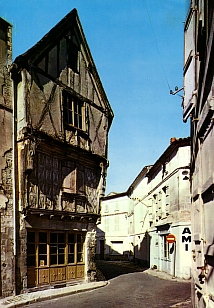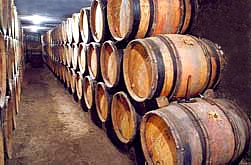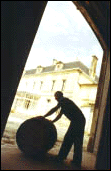|

It felt strange to see the "Cognac" sign at the railway
station, but Cognac was much like other small French towns: the old quarter a
cramped maze, a royal statue on the main square, loudspeakers in the pedestrian
mall. But on some streets a spirit became visible: the fungus that fed on brandy
fumes blackened the stone walls of centuries-old warehouses.

Fifteen years later I found the walls white. They cleaned up when the fungus
died after most of the brandy casks were moved outside town. I followed them and
found a visitors' centre with video presentations and trilingual staff in the
boutique selling T-shirts and snifters. Not a place for serious tasting but
probably good for business.

The little town, now 20,000 population, has been rich only for the past four
centuries. It grew a fragrant but thin wine that didn't travel well. In the 15th
century a Dutch captain tried to make transportation more efficient: he
distilled the wine for shipping, to be reconstituted after delivery -instant
wine: just add water and stir. The wine lost its taste in the process but the
undiluted liquid
gained a following. The English called it brandy after the Dutch word brandewijn
(burnt wine).
In the 1600s business slumped and the makers stored the surplus to wait for
higher prices. To their pleasant surprise, they found that brandy gained a
mellower flavour, richer aroma and colour from sitting around in oak casks.
Cognac was in business with Cognac brandy.
Few Cognac firms make wine or distill brandy themselves. They mostly blend the
raw material - raw eau-de-vie of 60% alcohol - bought from wine growers who distill
it at home or at nearby commercial distilleries. Some distillers use big stills
at the expense of taste, but others, like
Rémy
Martin, insist that suppliers use small pots (up to 25 hectoliter) and
distill "on the lees," the skins and seeds left under the wine. This produces
brandies with more perfume, deeper flavour and longer aftertaste. (This is not a
plug. I've been in love with Rémy's stuff forever.)

The makers dilute the eau-de-vie to 40% alcohol and pump it into oak casks to
mature. The most important activity in making brandy is leaving it alone. It
spends years in wood, picking up flavours, turning amber, mellowing. Some of it
evaporates. Some? Just from Rémy's stock, ten thousand bottles' worth rises to
heaven each day as the poetically named "angels' share."

Cognac improves in wood for only about fifty years. Some of the best are sealed
in glass carboys. They don't change in the glass (a five-year-old cognac bottled
in 1900 is only five-years-old), so they can be used as benchmarks of taste, and
for topping up the casks of younger brandies; the mellow spirits tame the
harshness of the young.

Carboy
In the last step, several brandies are blended to make a harmonious whole and
bottled. Each bottle contains brandies not only of different ages but of varied
origins. The hundreds of suppliers distill spirits as different as... well, as
hundreds of individualistic French peasants can be. How can a brandy have the
same flavour from year to year? The cellarmaster checks each purchase and
monitors the stock. He tastes up to fifty samples a day and knows where each
would fit in
the jigsaw puzzle of blending. The nose and tongue of the cellarmaster holds the
pattern for the signature taste for decades. His successor may train for ten
years.
Cognac is expensive, but you can amortize the cost if you invest some time to
get to know it. Look at the colour. It should be light; dark tinge betrays added
caramel or too much tannin. Swirl the glass to release perfumes. Do you find
vanilla, roast chestnuts, walnuts, dried fruit? The aroma should be smooth and
last as long as you inhale it. Before you taste, have a small sip to prime your
taste buds,
then sip more and chew. You'll really enjoy your brandy more.

Cognac is as much inhaled as drunk, and demands a glass that captures the
fragrance. Ostentation has ruined many a good cognac: the aroma gets lost in
outsized balloons. The best is an 8-oz snifter in which you pour about two
ounces. Cradle it in your hand to warm it and release the fragrance. Never use a
candle: it burns off the aroma. You can drink cognac on the rocks or as a
floater - cognac
poured on the top of soda water - the taste comes through remarkably well. I've
heard of using cognac to flambé a dish because it lends a richer flavour.
Perhaps. But I'll never have the heart to do it.

What's in a Name
All cognacs are brandy, but not all brandies are cognac. Only brandies distilled
from Cognac wine may be called cognac. The growing territory is subdivided. The
regions are - in order of rising quality - the Bois Ordinaires, Bons Bois, Fins
Bois, Borderies, Petite Champagne and Grande Champagne. These Champagnes have
nothing to do with where the bubbly is made, 400 miles north of here; the name
derives from the Latin campania (field). The name Fine Champagne states that the
wine came from the best areas, Grande and Petite Champagne. However, only
the description of origin is controlled. Any ordinary brandy may be called
Napoleon. (Not Bonaparte, hated by Cognac makers because his war against England
was bad for business. On the other hand, they loved Napoleon
III who brought back free trade.) Abbreviations indicate the years the brandies
in the blend spent in wood. Roughly, in VS (Very Superior) the youngest brandy
is 2-1/2 to 3 years old. In the VSOP (Very Superior Old Pale), the youngest is
4-5 years, but older additions raise the average age to about 12. In the XO
(Extra Old) Spécial, the average age rises to 25 years. These indicators and the
stars are
left to the discretion of the maker, just like your preference is left to your
taste.

|










